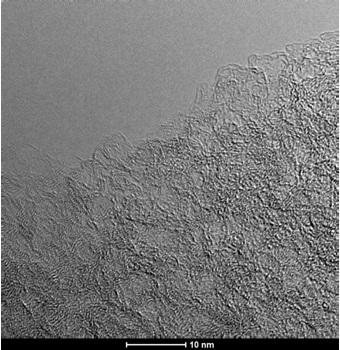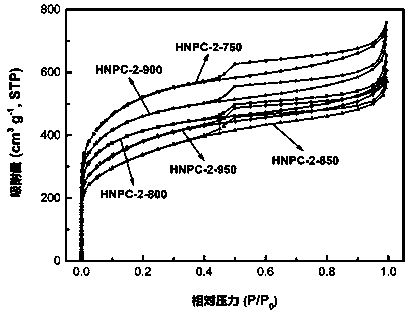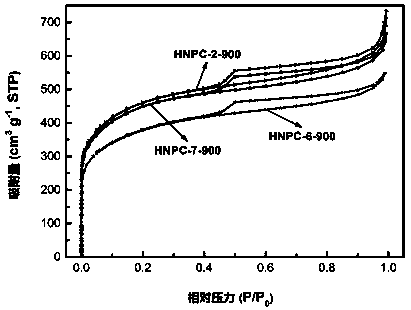Preparation method of all-pH fuel cell cathodic oxygen reduction electrocatalyst
A fuel cell cathode and electrocatalyst technology, which is applied in the field of preparing metal-free nitrogen-doped porous carbon and metal-free nitrogen-doped porous carbon materials, can solve the problems of reducing the catalytic stability of materials and increasing costs, and achieve the improvement of electrocatalytic performance , controllable conditions and simple preparation method
- Summary
- Abstract
- Description
- Claims
- Application Information
AI Technical Summary
Problems solved by technology
Method used
Image
Examples
Embodiment 1
[0049] (1) Collect the waste papaya peel, wash it with deionized water and dry it, weigh 3 g into a corundum boat, put it in a tube furnace, and under the protection of inert gas nitrogen, the ventilation rate is 80 mL min -1 , at 5 ℃ min -1 The temperature was raised to 400 °C at a rate of 2 h, and then at 5 °C min -1 Cool to 300 °C to obtain pre-carbonized product A1.
[0050] (2) Weigh 0.6 g of pre-carbonized product A1 and 1.8 g of melamine with an analytical balance at a mass ratio of 1:3, and then place them in a ball mill with a ball milling speed of 300 rpm. min, put the ball-milled mixture into a corundum boat, place it in a tube furnace, and under the protection of inert gas nitrogen, the ventilation rate is 80 mL min -1 , at 3°C min -1 The temperature was raised to 300 °C at a rate of 2 h, and then at 3 °C min -1 Cool to 100 °C to obtain nitrogen-doped product B1.
[0051] (3) Weigh 1.8 g of potassium bicarbonate with an analytical balance at a mass ratio of ...
Embodiment 2
[0056] (1) Collect the waste papaya peel, wash it with deionized water and dry it, weigh 3 g into a corundum boat, put it in a tube furnace, and under the protection of inert gas nitrogen, the ventilation rate is 80 mL min -1 , at 5 ℃ min -1 The temperature was raised to 400 °C at a rate of 2 h, and then at 5 °C min -1 Cool to 300°C to obtain pre-carbonized product A2.
[0057] (2) Weigh 0.6 g of pre-carbonized product A2 and 1.8 g of melamine with an analytical balance at a mass ratio of 1:3, and then place them in a ball mill with a milling speed of 300 rpm. min, put the ball-milled mixture into a corundum boat, place it in a tube furnace, and under the protection of inert gas nitrogen, the ventilation rate is 80 mL min -1 , at 3°C min -1 The temperature was raised to 300 °C at a rate of 2 h, and then at 3 °C min -1 Cool to 100 °C to obtain nitrogen-doped product B2.
[0058] (3) Weigh 1.8 g of potassium bicarbonate with an analytical balance at a mass ratio of 1:3 (A...
Embodiment 3
[0063] (1) Collect the waste papaya peel, wash it with deionized water and dry it, weigh 3 g into a corundum boat, put it in a tube furnace, and under the protection of inert gas nitrogen, the ventilation rate is 80 mL min -1 , at 5 ℃ min -1 The temperature was raised to 400 °C at a rate of 2 h, and then at 5 °C min -1 Cool to 300 °C to obtain pre-carbonized product A3.
[0064] (2) Weigh 0.6 g of pre-carbonized product A3 and 1.8 g of melamine with an analytical balance at a mass ratio of 1:3, and then place them in a ball mill with a ball milling speed of 300 rpm. min, put the ball-milled mixture into a corundum boat, place it in a tube furnace, and under the protection of inert gas nitrogen, the ventilation rate is 80 mL min -1 , at 3°C min -1 The temperature was raised to 300 °C at a rate of 2 h, and then at 3 °C min -1 Cool to 100 °C to obtain nitrogen-doped product B3.
[0065] (3) Weigh 1.8 g of potassium bicarbonate with an analytical balance at a mass ratio of ...
PUM
 Login to View More
Login to View More Abstract
Description
Claims
Application Information
 Login to View More
Login to View More - R&D
- Intellectual Property
- Life Sciences
- Materials
- Tech Scout
- Unparalleled Data Quality
- Higher Quality Content
- 60% Fewer Hallucinations
Browse by: Latest US Patents, China's latest patents, Technical Efficacy Thesaurus, Application Domain, Technology Topic, Popular Technical Reports.
© 2025 PatSnap. All rights reserved.Legal|Privacy policy|Modern Slavery Act Transparency Statement|Sitemap|About US| Contact US: help@patsnap.com



